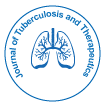Our Group organises 3000+ Global Conferenceseries Events every year across USA, Europe & Asia with support from 1000 more scientific Societies and Publishes 700+ Open Access Journals which contains over 50000 eminent personalities, reputed scientists as editorial board members.
Open Access Journals gaining more Readers and Citations
700 Journals and 15,000,000 Readers Each Journal is getting 25,000+ Readers
Useful Links
Related Subjects
Share This Page
Editorial Board
Submit Manuscript
If you are interested in publishing with us or have any questions, please feel free to contact us directly on WhatsApp .
About the Journal
Tuberculosis is an bacterial infection that can spread easily to any organ through blood stream and lymph nodes. It can affect many parts of the body, but most often affects lungs.
Journal of Tuberculosis and Therapeutics is a peer reviewed journal focuses on the publication of basic experimental research on tuberculosis, pathological aspects of the disease and therapy involved during in treatment. Journal mainly focus on clinical research and epidemiological studies on tuberculosis, drug resistance during therapy.
Journal of Tuberculosis and Therapeutics accepts manuscripts in the form of original research articles, review articles, case reports, short communications, letters to editor and editorials for publication in an open access platform. The journal uses editorial managerial system for maintaining quality of the whole process of manuscript submission, peer review and tracking.
The journal is using Editorial Manager for quality peer-review process. Editorial Manager is an online manuscript submission, review and tracking systems. Review processing is performed by the editorial board members of Journal of Tuberculosis and Therapeutics or outside experts; at least two independent reviewers approval followed by editor approval is required for acceptance of any manuscript. Authors may submit manuscripts and track their progress through the system. Reviewers can download manuscripts and submit their opinions to the editor. Editors can manage the whole submission/review/revise/publish process.
Tuberculin
Tuberculin is a mixture of antigens which are obtained from Mycobacterium tuberculosis. Antigens are the foreign particles which form a complex with antibodies. Two types of tuberculin are used: Old Tuberculin (OT) and Purified Protein Derivative (PPD).
Related Journals of Tuberculin
Applied Microbiology: open access, Journal of Bacteriology & Parasitology, Journal of Infectious Diseases and Diagnosis, Journal of Pulmonary & Respiratory Medicine, Mycobacteriology Scholarly journal, International Journal of Mycobacteriology, IJMYCO-International Journal of Mycobacteriology
Tuberculosis
It is an airborne Infectious disease caused by the bacterium Mycobacterium tuberculosis. It effects respiratory system and infects lungs in mammalian system. Tuberculosis can easily spread through air when TB active person cough, spit or sneeze. Active infection occurs more in people effected with HIV or who smoke. Symptoms of tuberculosis are cough with blood sputum, weight loss, fever.
Related Journals of Tuberculosis
Applied Microbiology: open access, Journal of Bacteriology & Parasitology, Journal of Infectious Diseases and Diagnosis, Journal of Pulmonary & Respiratory Medicine, Mycobacteria Journals, International Journal of Mycobacteriology, Mycobacterial Diseases Journals, Journal of clinical Mycobacterial diseases
Lymphadenitis
Lymphadenitis is the medical term for enlargement in one or more lymph nodes, usually due to infection. Lymph nodes are filled with white blood cells that help your body fight infections; a normal lymph node is small and firm. When lymph nodes become infected, they usually increase in size, become tender, and may be felt in other areas of your body during a physical exam, Infections that spread to lymph nodes are usually caused by bacteria, a virus, or a fungus.
Miliary Tuberculosis
Miliary tuberculosis is so named because of the innumerable tiny spots that form in the lungs are the size of millet, the small round seeds in bird food, Miliary tuberculosis may affect one organ or several organs or occur throughout the body. It often affects the lungs, liver, and bone marrow but may affect any organ, including the tissues that cover the brain and spinal cord and the membrane around the heart.
Bovine Tuberculosis
Bovine Tuberculosis (TB) is an infectious disease of cattle. It is caused by the bacterium Mycobacterium bovis which can also infect and cause disease in many other mammals including humans, deer, goats, pigs, cats, dogs and badgers, Infection is mainly through inhalation or ingestion of the bacteria, Contaminated food and water can also be a source of infection, TB in humans can be caused by both Mycobacterium bovis and the human form, Mycobacterium tuberculosis, it is mainly a respiratory disease but clinical signs are rare.
Latent Tuberculosis
Latent tuberculosis infection is a condition in which a person is infected with Mycobacterium tuberculosis -complex but does not have active tuberculosis disease. People with latent tuberculosis infection are at risk of progressing to active tuberculosis. Therefore, it is essential that individuals at high risk of progression to active tuberculosis are identified through screening.
Antituberculous Drugs
Mycobacterial cell wall is composed of mycolic acids. This layer provides resistance against several antibiotics. Mycobacteria produces beta lactamase enzyme, which can be resisted to beta lactam antibiotics, such as Penicillin and cephalosporin. Macrolides, Rifampicin, Aminoglycosides are effective against Mycobacterium.
Related Journals of Antituberculous drugs
Applied Microbiology: open access, Journal of Bacteriology & Parasitology, Journal of Infectious Diseases and Diagnosis, Journal of Pulmonary & Respiratory Medicine, anti-mycobacterial therapy, World congress on Infectious diseases, Antimycobacterial therapy for Crohn's disease - Nature, Antimycobacterial Therapy for Tuberculosis
Multiple Drug Therapy
Taking several antibiotics at a time is called as multiple drug therapy. Most of the medicines are given as pills. Antibiotics such as rifampin, ethambutol, isoniazid are used initially. Special treatment is provided to the people effected by HIV and TB, drug resistant TB, pregnant women with TB.
Related Journals of Multiple-drug therapy
Mycobacterial Journals, Tuberculosis Journals, American Journal of Tuberculosis
Tuberculosis Cerebritis
Tuberculosis most commonly involves the lungs, one with the involvement of the central nervous system (CNS) is the most serious type of systemic tuberculosis due to its high mortality rate, common neurological complications and sequelae, Tuberculous infections of the brain are most commonly caused by haematogenous spread of Mycobacterium tuberculosis secondary to a disease focus elsewhere in the body, such as the lung or the gastrointestinal tract, usually due to an affected lymph node eroding into a vessel The initial tuberculous lesions may develop either in the brain parenchyma or the meninges, and are known as Rich foci when they occur in the CNS.
Tuberculous Meningitis
Tuberculous meningitis is also known as TB meningitis or tubercular meningitis. Tuberculous meningitis is Mycobacterium tuberculosis infection of the meninges—the system of membranes which envelop the central nervous system, Mycobacterium tuberculosis of the meninges is the cardinal feature and the inflammation is concentrated towards the base of the brain. When the inflammation is in the brain stem subarachnoid area, cranial nerve roots may be affected. The symptoms will mimic those of space-occupying lesions.
Laryngeal Tuberculosis
Laryngeal tuberculosis is the most common granulomatous disease of the larynx and has usually been considered to result from pulmonary tuberculosis, although it might be localized in the larynx as a primary lesion without any pulmonary involvement, The diagnosis of LT may be difficult on account of the non-pathognomonic complaints and physical findings, especially in those patients without pulmonary disease, The infection begins with exudation in the subepithelial space followed by round cell infiltration and heals with fibrosis in LT.
Meningeal Tuberculosis
TB meningitis is caused by the bacterium Mycobacterium tuberculosis. TB meningitis is a life-threatening infectious disease that causes inflammation of the membranes that surround the brain and the spinal cord. These membranes are called the meninges – they help to protect the brain from injury and infection. The bacteria spread to the brain and spine from another place in the body.
Related Journals of Meningeal Tuberculosis
Applied Microbiology: open access, Journal of Bacteriology & Parasitology, Journal of Infectious Diseases and Diagnosis, Journal of Pulmonary & Respiratory Medicine, Atypical Mycobacterial disease, Atypical Mycobacterial Diseases Medication, Mycobacterial Diseases Journals, Nontuberculous mycobacterium infection
Tuberculous Pericarditis
Pericarditis caused by tuberculosis and it is difficult to diagnose, because diagnosis requires culturing Mycobacterium tuberculosis from aspirated pericardial fluid or pericardial biopsy. The Tygerberg scoring system helps the clinician to decide whether pericarditis is due to tuberculosis or whether it is due to another cause: night sweats, weight loss, fever, serum globulin > 40g/l, blood total leucocyte count <10 x 109/l; Pericardial fluid with an interferon-γ level greater than 50pg/ml is highly specific for tuberculous pericarditis.
Related Journals of Tuberculous Pericarditis
Applied Microbiology: open access, Journal of Bacteriology & Parasitology, Journal of Infectious Diseases and Diagnosis, Journal of Pulmonary & Respiratory Medicine, Tuberculous Pericarditis: Optimal Diagnosis and Management, Tuberculous Pericarditis - Circulation, A case of tuberculous pericardial effusion, Tuberculosis articles: The New England Journal of Medicine, Adenosine deaminase (ADA) in tuberculosis
Mantoux Tuberculin Test
Tuberculosis is identified in the laboratory by using one of the test called Mantoux test. It is more reliable and helps in the identification of TB Active persons. This test includes the procedure by injecting a small amount of PPD (Purified Protein Derivative) tuberculin intracutaneously. A small bubble is formed at the place where the tuberculin is injected. After 48-72 hours the test site will be examined. People who are exposed to tuberculosis will have a swelling at the place of injection, whereas TB negative person lacks the swelling.
Related Journals of Mantoux test
Applied Microbiology: open access, Journal of Bacteriology & Parasitology, Journal of Infectious Diseases and Diagnosis, Journal of Pulmonary & Respiratory Medicine, Mycobacteria Journals
Pulmonary Tuberculosis
Pulmonary tuberculosis (TB) is a contagious bacterial infection that involves the lungs. It may spread to other organs; Pulmonary TB is caused by the bacterium Mycobacterium tuberculosis. TB is contagious. This means the bacteria is easily spread from an infected person to someone else; you can get TB by breathing in air droplets from a cough or sneeze of an infected person. The resulting lung infection is called primary TB.
Pulmonary Tuberculosis
It occurs to the upper lobe of the right lung. Mycobacterium grow at high levels of oxygen and blood thus it effects lungs, and later on passes to other part of the body called as extrapulmonary tuberculosis. It is potentially deadly disease but it can be cured by medical help. Most of the people recover with primary TB. The infection may stay inactive for years, and it may become active again.
Related Journals of Antimycobacterial therapy
Applied Microbiology: open access, Journal of Bacteriology & Parasitology, Journal of Infectious Diseases and Diagnosis, Journal of Pulmonary & Respiratory Medicine, anti-mycobacterial therapy, World congress on Infectious diseases, Antimycobacterial therapy for Crohn's disease - Nature, Antimycobacterial Therapy for Tuberculosis
Tuberculous Osteomyelitis
Tuberculous osteomyelitis which does not involve a joint is uncommon and may fail to be diagnosed by an orthopaedic surgeon, Osteomyelitis is inflammation of the bone caused by an infecting organism, most of our patients had been treated initially with non-steroidal anti-inflammatory drugs which failed to provide relief. Bone pain which does not promptly respond to analgesic medication is often due to infection or neoplasia, although bone is normally resistant to bacterial colonization, events such as trauma, surgery, the presence of foreign bodies, or the placement of prostheses may disrupt bony integrity and lead to the onset of bone infection.
Mycobacterium Tuberculosis
It is an obligate, pathogenic species which belongs to the family Mycobacteriaceae and the causative agent of tuberculosis. It was first discovered by Robert Koch in the year 1882. Mycobacterium is covered by a waxy layer on its surface due to the presence of mycolic acid. The cells are impervious to Gram’s staining (Gram negative staining) in clinical lab. Mycobacterium tuberculosis can appear red in colour on Acid fast staining.
Related Journals of Mycobacterium tuberculosis
Applied Microbiology: open access, Journal of Bacteriology & Parasitology, Journal of Infectious Diseases and Diagnosis, Journal of Pulmonary & Respiratory Medicine, Bacteriology Journals, Immunology & Microbiology Journals, Molecular Biology Journals, Molecular Medicine Journals
Non Pulmonary Tuberculosis
It is a serious disease of global importance. Non-Pulmonary TB is mostly common in females. Non-Pulmonary TB disease (meningitis, miliary, pericardial) it is suggested that empiric treatment be commenced while appropriate diagnostic samples are being obtained.
Related Journals of Non-Pulmonary Tuberculosis
Applied Microbiology: open access, Journal of Bacteriology & Parasitology, Journal of Infectious Diseases and Diagnosis, Journal of Pulmonary & Respiratory Medicine, Atypical Mycobacterial disease, Atypical Mycobacterial Diseases Medication, Mycobacterial Diseases Journals, Nontuberculous mycobacterium infection
Gastrointestinal Tuberculosis
Gastrointestinal tuberculosis refers to the infection of abdominal organs with Mycobacterium tuberculosis, A point worthy of mention is that tuberculosis can affect virtually any organ system directly (primary pulmonary tuberculosis) or indirectly (via spread from primary), It generally affects the following organs: ileocaecal junction (terminal ileum and caecum): most commonly due to the abundance of lymphoid tissue, colon, liver, spleen, peritoneum, lymph nodes.Journal Highlights
Fast Editorial Execution and Review Process (FEE-Review Process):
Journal of Tuberculosis and Therapeutics is participating in the Fast Editorial Execution and Review Process (FEE-Review Process) with an additional prepayment of $99 apart from the regular article processing fee. Fast Editorial Execution and Review Process is a special service for the article that enables it to get a faster response in the pre-review stage from the handling editor as well as a review from the reviewer. An author can get a faster response of pre-review maximum in 3 days since submission, and a review process by the reviewer maximum in 5 days, followed by revision/publication in 2 days. If the article gets notified for revision by the handling editor, then it will take another 5 days for external review by the previous reviewer or alternative reviewer.Acceptance of manuscripts is driven entirely by handling editorial team considerations and independent peer-review, ensuring the highest standards are maintained no matter the route to regular peer-reviewed publication or a fast editorial review process. The handling editor and the article contributor are responsible for adhering to scientific standards. The article FEE-Review process of $99 will not be refunded even if the article is rejected or withdrawn for publication.
The corresponding author or institution/organization is responsible for making the manuscript FEE-Review Process payment. The additional FEE-Review Process payment covers the fast review processing and quick editorial decisions, and regular article publication covers the preparation in various formats for online publication, securing full-text inclusion in a number of permanent archives like HTML, XML, and PDF, and feeding to different indexing agencies.

 Spanish
Spanish  Chinese
Chinese  Russian
Russian  German
German  French
French  Japanese
Japanese  Portuguese
Portuguese  Hindi
Hindi 


